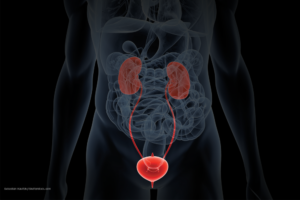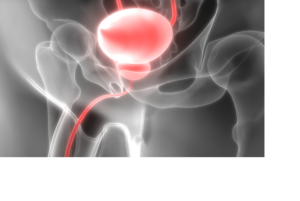Papillary Urothelial Carcinoma Specimens
Bay Biosciences provides high quality, clinical grade bio-samples, cryogenically preserved tumor tissue samples, sera (serum), plasma and PBMC bio-fluid specimens from patients diagnosed with Papillary Urothelial Carcinoma.
The sera (serum), plasma and peripheral blood mononuclear cells (PBMC) biofluid samples are processed from patient’s peripheral whole-blood using customized collection and processing protocols. The papillary urothelial carcinoma samples are collected from unique patients diagnosed with papillary urothelial carcinoma and are provided to a valued pharmaceutical customer for research, diagnostics, discovery and development.

Urothelial Carcinoma
Urothelial Carcinoma is also known as Transitional cell carcinoma, is a type of cancer that typically occurs in the urinary system. It is the most common type of bladder cancer and cancer of the ureter, urethra and renal pelvis. It accounts for 95% of bladder cancer cases. It is the second most common type of Kidney cancer, but accounts for only five to 10 percent of all primary renal malignant tumors. Transitional cell carcinomas arise from the transitional epithelium, a tissue lining the inner surface of these hollow organs. The term “urothelial” specifically refers to a carcinoma of the urothelium, which means a transitional cell carcinomas of the urinary system. Urothelial cancers occur more commonly in white men than in women and have a peak incidence in the age of 70 years.
Papillary Urothelial Carcinoma Overview
Papillary urothelial carcinoma is a type of bladder cancer which starts in urothelial cells in the bladder lining. Urothelial cells also line the urethra, ureters, and other parts of the urinary tract, cancer can start in these areas, too.
Papillary tumors are thin, finger-like growths that start in the bladder lining and extend into the center of the bladder. Sometimes, these cancers stay in the bladder without growing or spreading. But more aggressive types of this cancer can also spread to other organs.
Types of Papillary Urothelial Carcinoma
Papillary tumor can be invasive or non-invasive. Noninvasive cancers are usually found only in the inner bladder layer, they haven’t reached the deeper layers of the bladder or spread to other organs. Whereas Invasive tumors are which have grown into the deeper layers of the bladder and they’re more likely to spread. Papillary tumors can also be low-grade or high-grade. Low-grade tumors look more like normal cells and tend to grow slowly and high-grade cancer cells look more abnormal and can grow quickly.
Papillary tumors of the bladder are divided into four types:
- Papilloma: This is a noncancerous tumor growing out of the bladder lining.
- Papillary urothelial neoplasm of low malignant potential (PUNLMP): This is a precancerous growth which is unlikely to grow and spread.
- Low-grade papillary urothelial carcinoma: These tumors tend to grow slowly, but they can come back after treatment.
- High-grade papillary urothelial carcinoma: These tumors grow more quickly and are more likely to spread.
Papillary Urothelial Carcinoma Stages
Bladder cancer is staged based on how aggressive the cancer is and where it has spread.
Stage 0a: This is also called noninvasive papillary urothelial carcinoma. This early-stage, noninvasive cancer is only found in the inner lining of the bladder which has not grown into the muscle or connective tissue of the bladder wall.
Stage 1: When the cancer has grown into the inner bladder lining, but it has not reached the muscle in the bladder wall.
Stage 2: When the cancer has spread into the bladder muscle, it is considered invasive cancer. However, stage 2 cancer has not spread to the lymph nodes.
Stage 3: When the cancer has spread into the layer of tissue around the bladder. It may have spread to the prostate (in a male patients), or into the uterus and vagina (in female patients). It has not spread to the lymph nodes or other organs of the body.
Stage 4: The cancer may have widely spread to lymph nodes and other distant parts of the body.
Papillary Urothelial Carcinoma Signs and Symptoms
Hematuria is the most common symptom in patients presenting with urothelial tract cancer. It is most often painless, unless obstruction due to a clot or tumor and/or deeper levels of tumor invasion have already occurred.
Urinary voiding symptoms of urgency, frequency, and/or dysuria are also seen in patients with cancers of the bladder or ureters but are uncommon in patients with cancers of the renal pelvis.
Vesical irritation without hematuria can be seen, especially in patients with carcinoma in situ of the urinary bladder.
Symptoms of advanced disease- Pain is usually a symptom of more advanced disease, as is edema of the lower extremities secondary to lymphatic obstruction.
Symptoms of papillary urothelial carcinoma/bladder cancer includes:
- Blood in the urine
- Urgent need to urinate
- Need to frequently urinate than usual
- Pain during urination
When the papillary urothelial/bladder cancer spreads, symptoms can include:
- Loss of appetite
- Weight loss
- Lower back Pain
- Night sweats
- Fatigue
- Weakness
- Fever
- Swelling in the feet
Causes of Papillary Urothelial Carcinoma
Causes of urothelial cancers include:
Smoking: Cigarette smoking is the leading cause of all bladder cancers, including urothelial cancers. If you smoke, you are about three times as likely to get bladder cancer as compared to someone who doesn’t smoke. A strong correlation exists between the duration and amount of cigarette smoking and cancers at all levels of the urothelial tract. This association holds for both transitional cell and squamous cell carcinomas.

Occupational Exposure: Being exposed to certain chemicals at work site can increase the risk of developing urothelial/bladder cancer. People who work in the rubber, textile, paint, printing, and dye industries may be exposed to various toxic chemicals that have been linked to developing bladder cancer.
Balkan Nephropathy: An increased risk of cancer of the renal pelvis and ureters occurs in patients with Balkan nephropathy. This disorder is a familial nephropathy of unknown cause that results in progressive inflammation of the renal parenchyma, leading to renal failure and multifocal, superficial, low-grade cancers of the renal pelvis and ureters.
Medicines and Supplements: Overusing relievers containing phenacetin may increase the risk of urothelial/bladder cancer. Abuse of compound analgesics, especially those containing phenacetin, has been associated with an increased risk of cancers of the urothelial tract. This risk appears to be greatest for the renal pelvis, and cancer at this site is usually preceded by renal papillary necrosis. The risk associated with analgesic abuse is seen after the consumption of excessive amounts (5 kg). Herbal supplements containing aristolochic acid may also increase the risk of developing urothelial/bladder cancer.
Chronic Urinary Tract Inflammation, bladder infections or irritation: Having repeated urinary tract infections or developing bladder/kidney stones has been linked to bladder cancer. Upper urinary tract stones are associated with renal pelvis cancers. Chronic bladder infections can predispose patients to cancer of the bladder, usually squamous cell cancer.
Family history: Some bladder cancers run in families. Urothelial cancer is more common in families with Lynch syndrome, an inherited condition that makes people more likely to get several types of cancer. There are reports of families with a higher risk of transitional cell cancers of the urothelium, but the genetic basis for this familial clustering remains undefined.
Other factors: Other factors that can lead to papillary urothelial carcinoma include:
- Arsenic exposure
- Certain genetic mutations
- Previous treatment with certain chemotherapy drugs, such as cyclophosphamide
- Previous pelvic radiation
Papillary Urothelial Carcinoma Diagnosis
Initial work-up: The initial evaluation of a patient suspected of having urothelial cancer consists of excretory urography, followed by cystoscopy. In patients with upper tract lesions, retrograde pyelography can better define the exact location of lesions. Definitive urethroscopic examination and biopsy can be accomplished utilizing rigid or flexible instrumentation.
At the time of cystoscopy, urine is obtained from both ureters for cytology, and brush biopsy is obtained from suspicious lesions of the ureter. Brush biopsies significantly increase the diagnostic yield over urine cytology alone. Also, at the time of cystoscopy, a bimanual examination is performed to determine whether a palpable mass is present and whether the bladder is mobile or fixed.
Evaluation of a primary bladder tumor: In addition to biopsy of suspicious lesions, evaluation of a bladder primary tumor includes biopsy of selected mucosal sites to detect possible concomitant carcinoma in situ. Biopsies of the primary lesion must include bladder wall muscle to determine whether there is invasion of muscle by the overlying carcinoma.
CT scan: For urothelial cancers of the upper tract or muscle invasive bladder cancers, a CT scan of the abdomen/pelvis is performed to detect local extension of the cancer and involvement of the abdominal lymph nodes.
Bone Scans: For patients with bone pain or an elevated alkaline phosphatase level, a radioisotope bone scan is performed.
Chest X-Ray: Completes the staging evaluation.
Pathology
Transitional cell carcinomas constitute 90% to 95% of urothelial tract cancers.
Squamous cell cancers account for 3% to 7% of urothelial carcinomas and are more common in the renal pelvis and ureters.
Adenocarcinomas account for a small percentage (< 3%) of bladder malignancies and are predominantly located in the trigone region. Adenocarcinomas of the bladder that arise from the dome are thought to be urachal in origin.
Carcinoma in situ- In approximately 30% of newly diagnosed bladder cancers, there are multiple sites of bladder involvement, most commonly with carcinoma in situ. Although carcinoma in situ can occur without macroscopic cancer, it most commonly accompanies higher disease stages.
When carcinoma in situ is associated with superficial tumors, rates of recurrence and disease progression (development of muscle invasion) are higher (50%–80%) than when no such association is present (10%). Carcinoma in situ involving the bladder diffusely without an associated superficial tumor is also considered an aggressive disease. Most patients with this type of cancer will develop invasive cancers of the bladder.

Papillary Urothelial Carcinoma Treatment
The treatment will depend on the stage of the Urothelial/bladder cancer.
Stage 0
Noninvasive papillary carcinoma is often treated with a procedure called transurethral resection of bladder tumors (TURBT). The surgeon places an instrument up the urethra into the bladder and removes any abnormal tissue.
Stage 1
Stage1 urothelial/bladder cancers are treated with TURBT followed by intravesical therapy. During intravesical therapy, the doctor places a catheter into the bladder to deliver medication straight into the bladder. immunotherapy or chemotherapy is delivered to the body this way. Immunotherapy uses a type of bacteria called Bacillus Calmette-Guerin (BCG). These germs alert the immune system, which attacks the bladder cancers cells. Chemotherapy uses chemicals to kill cancer cells.
Stage 2
Stage 2 cancers are treated with a partial or total cystectomy, depending how deep the cancer has grown and invaded into the bladder. Partial cystectomy removes the part of the bladder where the cancer is located. Total cystectomy removes the whole bladder, nearby lymph nodes may be removed, too if the cancer is found. Chemotherapy may also be administered before or after the surgery to prevent the cancer from coming back.
Stage 3
Stage 3 Urothelial/bladder cancer treatment includes partial or total cystectomy, along with chemotherapy. Radiation and immunotherapy may be options, as well.
Stage 4
Stage 4 Chemotherapy is the main treatment for stage 4 cancer. You might also get radiation or immunotherapy, or a surgery may also be an option.
Generally papillary urothelial cancer have a better prognosis than other types of bladder cancer. Specific outlook depends on the stage and grade of the cancer. High-grade cancers can spread. Low-grade papillary cancer are less likely to spread. Papillary cancer can also return and relapse after they’ve been treated.

Detailed clinical data, MRI, CT, chest X-Ray, bone scans, excretory urography, cystoscopy, retrograde pyelography, urethroscopic examination, tumor tissue, brush biopsy, urine and blood analysis, elevated biomarker levels, genetic and metabolic information, histopathological findings associated with urothelial carcinoma patient’s specimens is provided to a valued customer for research, diagnostics, development and drug discovery. The urothelial carcinoma samples PBMC’s, sera and plasma biofluids are processed from patients peripheral whole-blood using customized collection and processing protocols.
Bay Biosciences is a global leader in providing researchers with high quality, clinical grade, fully characterized human tissue samples, bio-specimens and human bio-fluid collections from cancer (tumor) tissue, cancer–serum, cancer–plasma cancer-PBMC and human tissue samples from most other therapeutic areas and diseases.
Bay Biosciences maintains and manages it’s own bio-repository, human tissue bank (biobank) consisting of thousands of diseased samples (specimens) and from normal healthy donors available in all formats and types. Our biobank procures and stores fully consented, deidentified and institutional review boards (IRB) approved human tissue samples and matched controls.
All our human human tissue collections, human specimens and human bio-fluids are provided with detailed samples associated patient’s clinical data. This critical patient’s clinical data includes information relating to their past and current disease, treatment history, lifestyle choices, biomarkers and genetic information. Patient’s data is extremely valuable for researchers and is used to help identify new effective treatments (drug discovery & development) in oncology, other therapeutic areas and diseases. This clinical information is critical to demonstrate their impact, monitor the safety of medicines, testing & diagnostics, and generate new knowledge about the causes of disease and illness.
Bay Biosciences banks wide variety of human tissue samples and biological samples including cryogenically preserved -80°C, fresh, fresh frozen tissue samples, tumor tissue samples, FFPE’s, tissue slides, with matching human bio-fluids, whole blood and blood derived products such as serum, plasma and PBMC’s.
Bay Biosciences is a global leader in collecting and providing human tissue samples according to the researchers specified requirements and customized, tailor made collection protocols. Please contact us anytime to discuss your special research projects and customized human tissue sample requirements.
Bay Biosciences provides human tissue samples (human specimens) from diseased and normal healthy donors; including peripheral whole-blood, amniotic fluid, bronchoalveolar lavage fluid (BAL), sputum, pleural effusion, cerebrospinal fluid (CSF), serum (sera), plasma, peripheral blood mononuclear cells (PBMC’s), saliva, Buffy coat, urine, stool samples, aqueous humor, vitreous humor, kidney stones, renal calculi, nephrolithiasis, urolithiasis and other bodily fluids from most diseases including cancer. We can also procure most human bio-specimens and can do special collections and requests of human samples that are difficult to find. All our human tissue samples are procured through IRB approved clinical protocols and procedures.
In addition to the standard processing protocols Bay Biosciences can also provide human plasma, serum, PBMC bio-fluid samples using custom processing protocols, you can buy donor specific sample collections in higher volumes and specified sample aliquoting from us. Bay Biosciences also provides human samples from normal healthy donors, volunteers, for controls and clinical research, contact us Now.
日本のお客様は、ベイバイオサイエンスジャパンBay Biosciences Japanまたはhttp://baybiosciences-jp.com/contact/までご連絡ください。



